

Movie
Horror Movie Metaphors
As a genre, Horror is arguably the most scoffed at for its gratuitous violence and gore. Not to mention the abject sexism of female sexuality being ultimately punished or having severe consequences. If you look beyond the cheap jump scares and corn syrup blood; horror (when done right) has the ability to be the most creative and thought-provoking lens in which to view the human experience. With the added suspension of belief, Horror has more scope to get creative with its messages and metaphors.
The creators may hint at their intentions with the movies but the majority of this discourse is fan theory and opinion.
Here are a few of my favorite metaphors in horror movies:

10: NOPE
Jordan Peele is a horror director known for exploring social issues in his movies. 2022’s NOPE may not have the obvious hints of sociopolitical commentary as his previous movies; Us (2019) and Get Out (2017). Yet NOPE still contains a culturally relevant metaphor many fans and film critics agree on. NOPE is generally considered to be a metaphor for fame. The siblings (played by Daniel Kaluuya and Keke Palmer) in the film even work on a ranch training horses for use in Hollywood films. The gargantuan alien entity in NOPE picks up its prey, such as humans and horses, and spits it what it can’t digest. Much like the way fame picks up aspiring performers; takes what is useful to it, spits out the rest then quickly moves on.
NOPE also heavily features the use of cameras and photographic imagery. In the world of NOPE you can’t stare at the alien or it will notice you then proceed to eat you. The film’s heroes cannot look directly at the monster. This could be likened to actors ‘spiking the lens’ or looking directly into a camera and breaking the fourth wall which is usually discouraged. Peele himself has remarked that NOPE’s central theme is exploitation, particularly the historical exploitation of people of color.
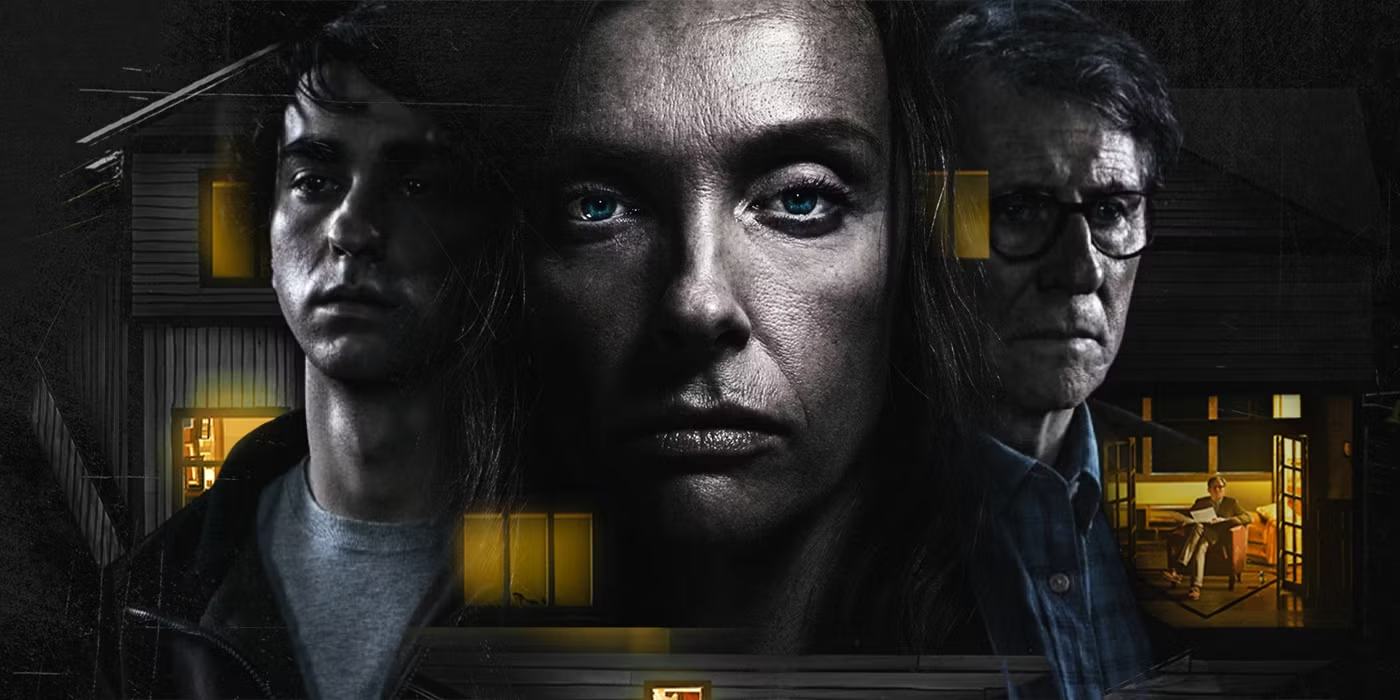
9: Hereditary
The clue is in the title. Ari Aster’s 2018 masterpiece is widely recognized as a metaphor for generational trauma. The machinations of Ellen, the grandmother of the family portrayed, effect not only her daughter Annie (played by Toni Collette) but her grandchildren too. The trauma is reimagined as Ellen’s worship of the demon king; Paimon. This worship has corrupted the family through the generations culminating in its absolute destruction.
The movie cleverly shows how our identities and fears are shaped by those who came before us.

8: SMILE
Much like Hereditary 2022’s SMILE reimagines demon possession as something that can be passed on from person to person. The demon in question symbolizes how the cycle of trauma continues following victims around like an evil faceless entity. Hurt people hurt people and they pass the entity (of abuse) on until it becomes a chain. In the narrative of the film, we are told that the unnerving smiles (which denote the presence of the demon) can appear on the faces of people you know, loved ones, or even strangers. Does this symbolize how anyone can cause you trauma? It has to be noted that the faces the demon wears when haunting the film’s protagonist Rose, are mainly the faces of her loved ones. It is a universally accepted fact that you are more likely to be attacked by a loved one than a stranger.
In psychological terms, trauma can only really be processed and ‘beaten’ when it is confronted and dealt with. SMILE mirrors this by having Rose take control and face her demons, both metaphorical and supernatural.

7: Candyman
Candyman is an extremely recognizable horror movie icon. The role was immortalized by Tony Todd in the 1992 original. In the 2021 reboot, Yahya Abdul-Mateen II takes up the mantle of Candyman and changes the trajectory of the franchise.
Candyman is a metaphor for extreme racism. The original Candyman was an artist by the name of Daniel Robitaille, who was mutilated and tortured to death for his relationship with a white woman. All the anger and hate that caused this atrocity manifested itself into the sinister supernatural killer.
Candyman in both original and reboot discusses gentrification and the ghettoization of predominantly black, low socioeconomic areas (Chicago’s Cabrini-Green). In 2021 Candyman, The Candyman is summoned to stop the gentrification of Cabrini-Green.
Candyman fans have criticised the reboot as it paints the Candyman as some kind of hero or dark knight when in the original he was the unquestionable villain. Although the original hinted at social issues the reboot has been accused of being too preachy and allowing the message to trump the story. There are many nods to current movements such as the 2021 protagonist Anthony creating an art show called ‘Say My Name’. This echoes one of the war cries of a modern movement; ‘Say Their Names’ for the victims of police brutality. Despite these discrepancies, Both versions are an allegory for how racism and racially motivated hate crimes echo throughout history to the modern day.

6:Rosemary’s Baby
1968’s Rosemary’s Baby has multiple interpretations but one of the most common is that the movie is a metaphor for misogyny and coercive control. Rosemary’s husband Guy Woodhouse wants to succeed in his acting career, and to do this he strikes a deal with his Satanist neighbors (as you do). Guy agrees to provide Rosemary as an incubator for the antichrist, unbeknownst to Rosemary. The married couple decide to have a baby and one night Rosemary is drugged by the satanic neighbours. With Rosemary incapacitated Guy and the neighbors summon Satan who rapes Rosemary and impregnates her with the antichrist.
The next morning Rosemary notices scratches on her back and Guy claims they got drunk and he had sex with her unconscious body (know it was the 60’s but my god!). Guy clearly sees Rosemary as an object and part of his property that he can ‘rent’ out. Rosemary is gaslighted by pretty much every character in the film. Her male doctor (also a member of the cult) even dismisses her fears when she confides in him. The doctor sends her back to her abusers. Reminiscent of women’s pain being dismissed by the medical community for centuries.

5:Drag Me to Hell
Sam Raimi’s 2009 film Drag Me to Hell has the most interesting fan interpretation. Many fans believe the film is a metaphor for eating disorders.
The film’s protagonist Christine (Alison Lohman) is a perfectionist and people pleaser which are personality traits known to be susceptible to eating disorders. The opening shot of the film has Christine looking longingly at desserts through a shop window with a pained expression on her face. At one point in the movie; a slice of cake develops an eyeball and stares at Christine.
Both vomit and Christine being vomited on is a big component of the film to the point of being beyond gratuitous. We also find out that Christine used to be a heavy child and had a traumatic childhood with her father dying and her mother succumbing to alcoholism, this type of upbringing is prime for developing an eating disorder. In the movie when Christine is upset she eats ice cream because she ‘doesn’t care anymore’ despite telling her boyfriend she is lactose intolerant.
In a broader sense, the film’s narrative has Christine being stalked by a demon wanting to (you guessed it) drag her to hell. Many sufferers reimagine their illness(s) as monsters or demons as a coping mechanism.
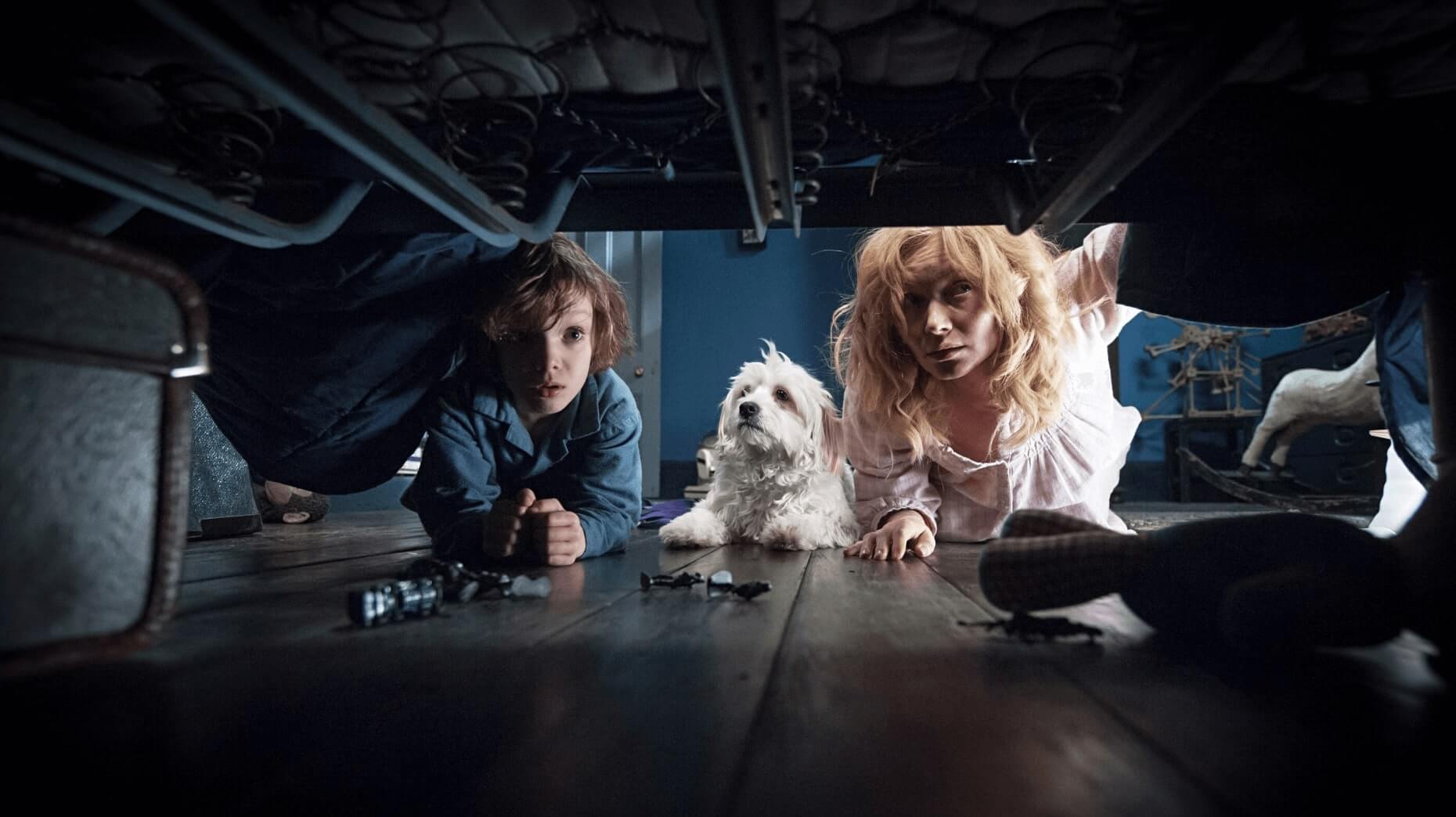
4: The Babadook
The Babadook (2016) monster is believed to be the representation of the mother Amelia (Essie Davis) grief and depression over the loss of her husband. The Babadook is a monstrous accumulation of all the negative feelings and memories Amelia has been repressing since her husband’s death. Her seven-year-old son asks her not to let Mister Babadook into the house and not let the bad feelings in. Ultimately the mother and son discover you can’t fully get rid of the Babadook (bad feelings, bad memories) so they lock him in their basement and feed the monster dirt and worms once a day. Worms and dirt can represent death and decay like Amelia is accepting the death of her husband. Amelia has also opened a literal can of worms by letting these feelings into their life. Grief and depression don’t just disappear, you need to acknowledge and accept them and sit with them even if it’s just once each day.

3: The Witch
Like Rosemary’s Baby, The Witch (2015) is open to many different interpretations. But the most common is the fear of female sexuality. New England Puritan society was the ultimate patriarchy. The Puritans believed women to be not only lesser but more susceptible to evil. The film’s protagonist Thomasin (Anya Taylor-Joy) grows up in this belief system. Thomasin’s age is not explicitly stated anything between 15 – 18. Old enough that her burgeoning sexuality would be considered a problem by her family. Her younger brother even lusts after her as he has never been in contact with other females. Thomasin is blamed for all the families ‘sins and problems to the point where her parents discuss selling her into servitude.
Puritan women could look forward to a life of household labor, childbirth, and being blamed for pretty much everything. During the Salem Witch Trials ‘witnesses’ attempted to use spectral evidence to condemn the women. Having dreams about the women coming into their bedrooms and trying to ‘tempt’ them. Which is basically just blaming the condemned women for their own sexually charged dreams and/or fantasies. Women essentially died because men fantasized about them. In The Witch the family’s sins are projected onto Thomasin the same way Puritan society projected their sins onto innocent women.
Thomasin is liberated from this life by Black Philip (Satan in disguise) and becomes a witch. Why when she is levitating in the woods she is laughing, now she can live deliciously.
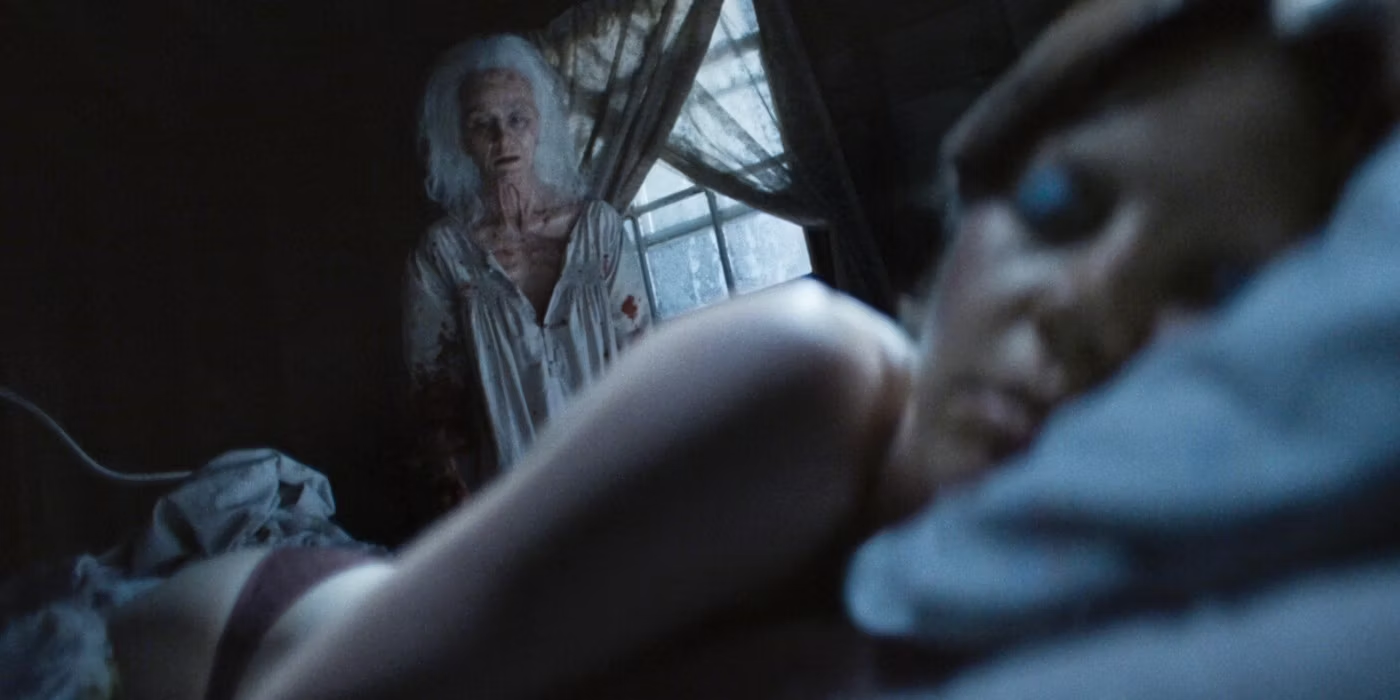
2: X
Ty West’s 2022 offering X could be a commentary on the fear of growing old, particularly women; losing their looks and perceived sexual power over men. The character of Pearl is jealous of Maxine’s youth, beauty, and freedom. When the two meet Pearl’s old and frail hand is seen longingly stroking Maxine’s bare back. The movie could also illustrate the struggle to combine your past and present selves. Both Pearl and Maxine are played by Mia Goth. In one scene Pearl is seen brushing her hair and doing her makeup similar to that of Maxine’s. Pearl even gets into bed with a sleeping Maxine.
The film also explores the loss of sexual virility and desire. It is fitting as Maxine and her group are trying to covertly film an X-rated movie on Pearl’s farm. Pearl and her elderly husband rectify this cognitive dissonance by having sex in Maxine’s bed with Maxine hiding underneath.
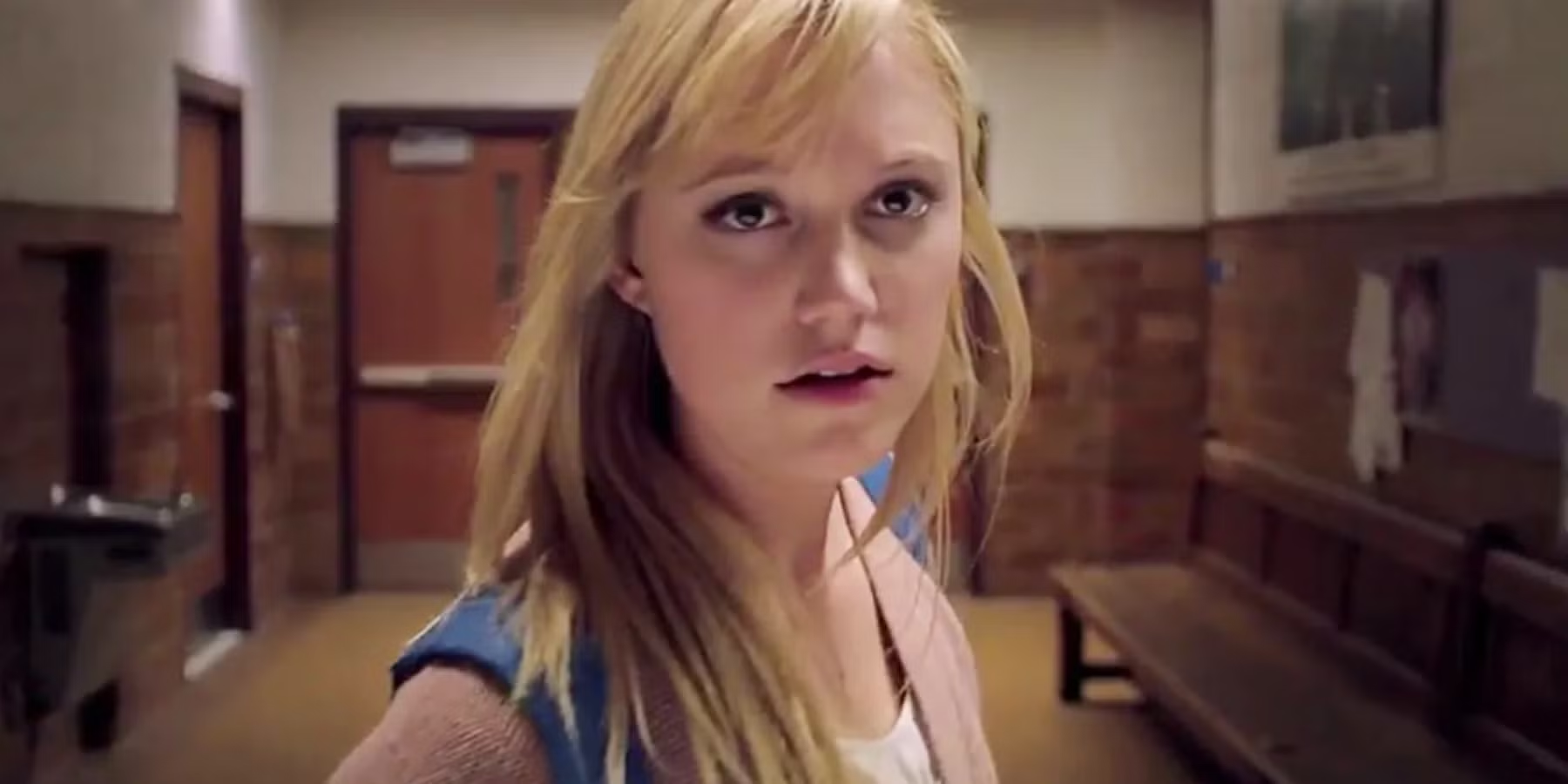
1:IT Follows
IT Follows (2015) is a fantastic subversive look into the meta world of a brilliant horror movie. IT Follows is so expertly nuanced that fans have been debating over its meaning. A sexually transmitted monster could be easily translated into multiple metaphors. Everything from an STD metaphor to rape culture, even a pandemic.
The metaphor I find the most compelling is the monster being a metaphor for death. It has to be said most horror movies are in some way a metaphor for death but IT Follows explores it in such a unique way. The young female protagonist Jay (Maika Monroe) has sex and inherits the monster from her partner. Sex does not open the door to self-actualization and adulthood as young people expect. Instead life becomes scary as you are stalked by a faceless monster. The young cast in the film are made aware of their own mortality and all they can is have sex and pass on the monster.
Like SMILE the monster borrows faces from strangers and the protagonist’s loved ones. There is no rhyme or reason to why and when the monster chooses which faces. Much like death, we try to make it logical but no one understands it. Ironically there is a French phrase ‘la petit mort’ meaning a little death or brief loss of consciousness during sex. In the movie having sex is the only thing that keeps the monster away however briefly. The world of IT Follows has no exact time period. There is a mix of past, present, and future technology and styles. This could represent the fact that Jay’s realization spans across human history.
Jay stares at screens, tries to eat, and spends time with her friends to try and distract herself from the slow trudging monster following her. She doesn’t know where and she doesn’t know when but it’s coming. Fans have commented that many of the casts conversations in the movie are very mundane and so unlike the manufactured conversations of movies. It’s argued this is a commentary on how we are all just sitting around waiting to die.
And on that cheerful note!
Movie
‘Mufasa: The Lion King’ Will Leave You Breathless
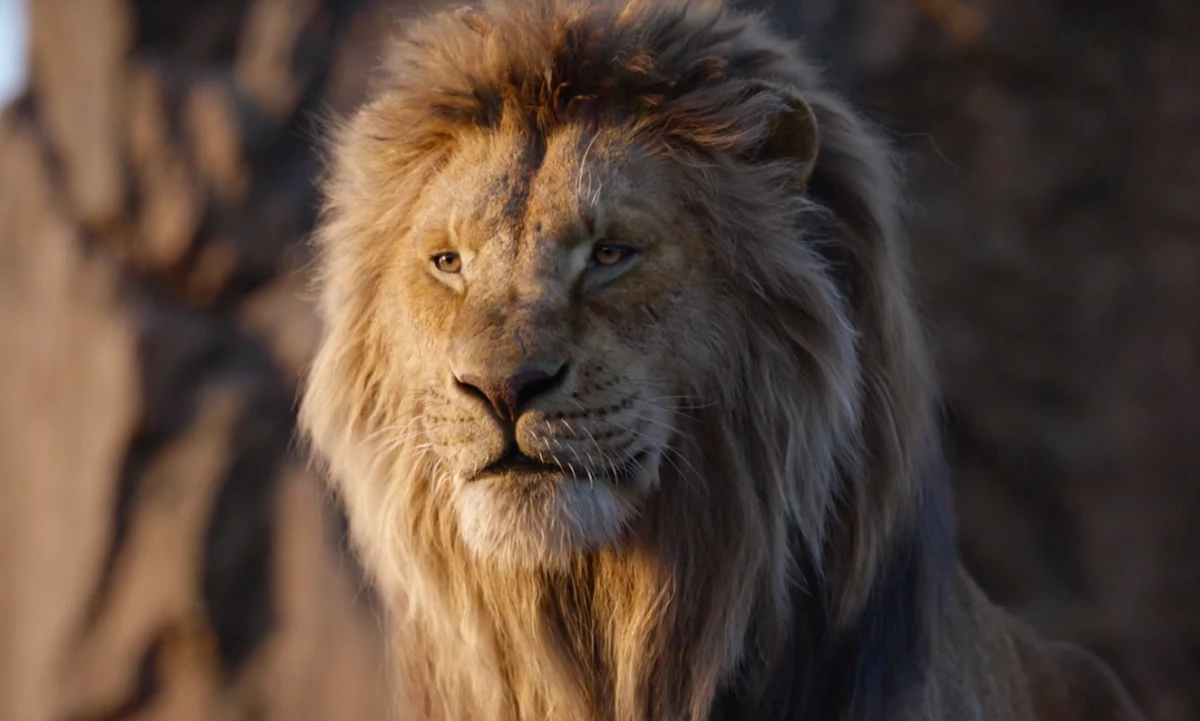
“Mufasa: The Lion King” is a visually stunning addition to the beloved Lion King franchise, offering a fresh and emotionally resonant take on the origins of one of Disney’s most iconic characters. The film beautifully explores Mufasa’s journey, balancing heartfelt moments with touches of comedy that lighten the mood and make the story accessible to audiences of all ages. The animation is breathtaking, capturing the vibrant landscapes and lush environments of the Pride Lands, adding depth to Mufasa’s character and his relationships.
The storytelling is compelling, effectively pulling at the heartstrings while providing insights into Mufasa’s character before he becomes the legendary king. However, the setup for Scar’s betrayal feels somewhat underdeveloped, lacking the deeper motivation that could have enriched their complex brotherly relationship. This missed opportunity leaves a slight gap in understanding Scar’s actions, which could have elevated the dramatic stakes.
The musical score is impressive, featuring memorable songs that enhance the emotional impact of pivotal scenes. While there are several standout tracks, one song, in particular, resonates deeply and is sure to linger in viewers’ minds long after the credits roll. Overall, “Mufasa: The Lion King” is an amazing film and a worthy addition to the Lion King lore that manages to deliver both laughter and tears, offering a rich tapestry of storytelling that fans will appreciate.
Movie
Is ‘Kraven the Hunter’ a Total Letdown?

“Kraven the Hunter,” directed by J.C. Chandor, aims to introduce a beloved Spider-Man villain to the big screen, but unfortunately, it falls short of expectations. The film suffers from noticeable issues, notably an overuse of ADR (Automated Dialogue Replacement), which detracts from the authenticity of the characters’ interactions and contributes to an uneven audio experience. This technical flaw is compounded by rough storytelling that feels disjointed and lacking in coherence, leaving viewers struggling to connect with the narrative.
Aaron Taylor-Johnson delivers a commendable performance as Kraven, showcasing the character’s gritty nature and complex motivations. His portrayal has potential, and it’s evident that he could elevate the character far beyond what is presented with a stronger script and direction. However, the absence of Spider-Man, a central figure in Kraven’s lore, leaves a void that the film struggles to fill. Without this critical connection, the plot meanders and fails to create the tension or stakes that fans of the superhero genre crave.
Additionally, including Rhino as a villain feels like a missed opportunity; he is presented more as a gag character with limited screen time, undermining any sense of threat or depth. For the average moviegoer, “Kraven the Hunter” might entertain but ultimately feels like a mediocre viewing experience. Comic book fans, however, may find disappointment in this lackluster attempt to create a solo character film. Instead of an exhilarating dive into Kraven’s world, the film presents a watered-down version, leaving audiences wishing for a more cohesive vision that honors its comic book roots.
Movie
A Brief Review and History of A Year Without a Santa Claus
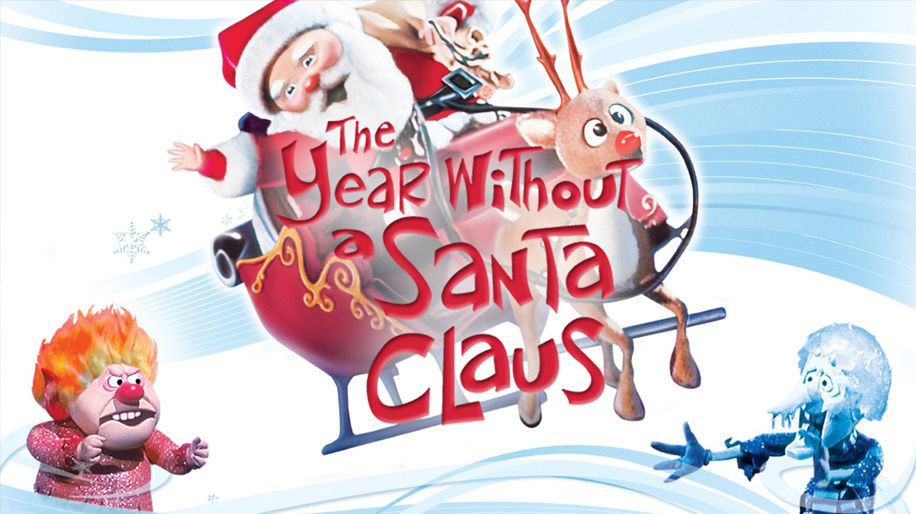
A Year Without a Santa Claus, the 1974 stop-motion holiday classic produced by Rankin/Bass, is a heartwarming and whimsical tale that has cemented its place in holiday traditions. Based on Phyllis McGinley’s 1956 book, the story revolves around a disheartened Santa Claus who, feeling unappreciated, decides to take a year off from his Christmas duties. It’s up to Mrs. Claus and a pair of well-meaning elves, Jingle and Jangle, to reignite the Christmas spirit and show Santa the world’s unwavering belief in him.
The movie is beloved for its unforgettable characters, especially the bickering Miser Brothers, Snow Miser and Heat Miser. Their catchy, vaudeville-style musical numbers, “Snow Miser Song” and “Heat Miser Song”, are so iconic they’ve become cultural touchstones, often parodied and celebrated decades later.
Directed by Arthur Rankin Jr. and Jules Bass, the film continues the duo’s tradition of stop-motion magic, blending heartfelt storytelling with quirky humor. The voice cast, featuring Mickey Rooney as Santa and Shirley Booth as Mrs. Claus, delivers standout performances. Booth’s warm narration was her final acting role before retirement, adding a layer of poignancy to the film.
Initially released on December 10, 1974, on ABC, the special didn’t immediately achieve the legendary status of Rudolph the Red-Nosed Reindeer. However, it gained a dedicated following through annual holiday airings, nostalgic appeal, and its distinct charm.
The film’s themes of hope, unity, and rekindling joy remain timeless, making it a perennial favorite for audiences of all ages. Its blend of humor, catchy songs, and a touching message about believing in magic and goodwill ensures its enduring legacy during the holiday season.
For fans of holiday classics, A Year Without a Santa Claus is a must-watch that never fails to warm hearts and spread cheer.


